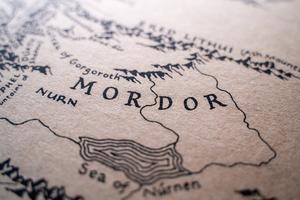‘The Lord of the Rings’ in a Nutshell
The key to understanding LOTR is to be found in the date on which the Ring is destroyed — March 25, the feast of the Annunciation

According to its author, J.R.R. Tolkien, The Lord of the Rings “is, of course, a fundamentally religious and Catholic work.” This might puzzle or mystify many people. There is, after all, no mention of Christ or his Church anywhere in its thousand or so pages.
The Catholic dimension is subsumed within the work, hidden under the literal surface in multifarious ways. Most specifically, the key to understanding the religious dimension of the work is to be found in the date on which the Ring is destroyed. This is March 25, a hugely significant date on the Christian calendar and perhaps the most significant date of all. Most Catholics will know that March 25 is the date of the Annunciation, the date on which the Word becomes flesh, the date of the Incarnation, when God becomes man. Since human life begins at conception, not birth, the Annunciation is more important than Christmas.
Many people, even Catholics, will not know that March 25 was also widely believed by those in the early and medieval Church to be the historical date of the Crucifixion. Since Good Friday is a movable feast, we don’t assign a particular date to the death of Christ, yet he died on one particular date in history. This date, according to tradition, was March 25. Tolkien, a medieval scholar, knew this and used it as the inspiration for the assigning of this date to the Ring’s destruction.
The Annunciation, taken together with the Crucifixion and Resurrection, constitutes our redemption, our liberation from the power of sin. Original Sin is the one sin to rule them all and in the darkness bind them. The Ring is the one ring to rule them all and in the darkness bind them. The one Sin and the one Ring are both destroyed on the same significant date.
The power of the Ring is, therefore, an allegorical depiction of the power of sin. The act of putting on the Ring is the act of sin. The Ring-wearer is living in sin. He becomes invisible to the good world that God has made, excommunicating himself from the light of goodness, truth and beauty, but becomes more visible to the demonic Sauron who rules wherever the shadow of sin shields the sinner from the light.
On the other hand, the one who bears the weight of the Ring, the weight of sin, without succumbing to its power, is bearing the cross. The Ring-bearer is the cross-bearer. In this sense, Frodo Baggins is both a Christ figure and a figure of one who follows Christ by taking up his cross. It is, therefore, not surprising that Frodo leaves Rivendell on Dec. 25 and arrives at Mount Doom (Golgotha) on March 25, his journey matching the life of Christ from the Nativity to the Crucifixion.
In addition to this overarching Christological and cosmological dimension of Frodo’s quest, The Lord of the Rings contains a couple of other dexterously suggestive figures of Christ. First is Gandalf, whose death and resurrection is accompanied by his transfiguration from being Gandalf the Grey to Gandalf the White; second is Aragorn, whose true kingship gives him the power to descend into the paths of the dead, releasing the dead themselves from their curse.
Apart from the aforementioned Christ figures, Tolkien’s epic also presents several Everyman figures, evocative of Tolkien’s insistence in his famous essay “On Fairy-Stories” that fairytales hold up “a mirror to man.” They show us ourselves. This is most evident in the character of Boromir, who is the official representative of the race of men in the Fellowship of the Ring. He is there on our behalf. It is he who betrays the Fellowship, seeking to use the power of the Ring to save his own people. This willingness to use evil means to a purportedly good end leads only to the ultimate triumph of evil because sin can’t be used to defeat sin. Boromir repents and lays down his life for his friends. His final exchange of words with Aragorn reflects the form of the Sacrament of Penance, Aragorn acting in persona Christi as Boromir confesses his sin.
Faramir serves as another Everyman figure, as is evident analogically by his being Boromir’s brother. Faramir declares that he would not pick up the Ring if he saw it lying at the side of the road. He also says that he wouldn’t snare even an orc with a falsehood; not the smallest lie to the devil himself.
A third rather sobering Everyman figure is Gollum, whose addiction to the power of the Ring serves to highlight the shriveling and shrinking of the soul if it surrenders itself to the decadent quest for “self-empowerment.”
Much more could and should be said about the multifaceted and multifarious applicable meanings that emerge from this timeless classic. In essence, however, or in a nutshell, the key is to be found in the date on which the Ring is destroyed. From this, as from an acorn, Tolkien’s tree of tales reaches for the heavens.

















